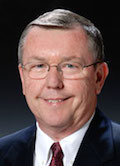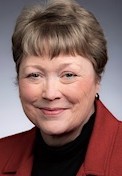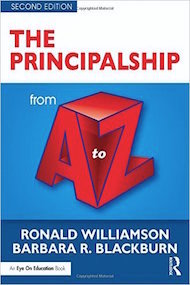Continuous Learning: Develop Your Own PLN
By Ronald Williamson and Barbara R. Blackburn

As the school year ends, the summer months provide an opportunity for school leaders to pause and reflect on the school year. It’s also is a time for renewal, a time to get refreshed and re-energized for the coming year. It’s often a time to focus on one’s own learning.

How do you stay on top of things? Well, we’ve learned from principals about how you can continue your own learning.
Embrace Being a Continuous Learner
Most important is to commit to continuous learning. Veteran, novice and aspiring principals all benefit from learning about new ideas, identifying the latest trends, and having an opportunity to interact with and learn from colleagues. Sharing your own learning is an important way to model for teachers about the value of continuous learning.
- Be intellectually curious. Read a lot, think a lot about current and emerging trends. Be open to ways to improve your school even when things are going well. Spend time with publications, both traditional and online, in education and in other fields, to learn about trends, new ideas and to promote your own thinking.
- Cultivate a critical friend, someone outside your school or outside education. Such a friend can provide a fresh perspective on issues you face.
- Actively participate in every professional development activity with your teachers and instructional coaches. Value the opportunity to learn from them, to reflect on your learning, and to apply it in your work.
- Talk with others about what you read, what you’ve watched, and what you learn. Sharing your learning models the importance of learning.
- Organize a discussion group with other principals. Identify a common interest, select a book of interest, and commit to sharing your thinking and ideas.
- Join the online communities of your professional association (AMLE, NAESP, NASSP, ASCD).
- Create your own book study group around a topic of interest and include principals and leaders in other community organizations.
- Enjoy what you do. Relish the impact that principals have on the education of students in their school. But when the enjoyment fades, find ways to reinvigorate your passion and model the importance of continuous learning.
The good news is that technology makes staying connected far easier than it has ever been. It’s now possible to create your own personalized Personal Learning Network (PLN) that helps link you to the information, tools and resources you find most helpful. (Poth, 2023; Williamson & Johnston, 2012).
Your Own Personal Learning Network
A Personal Learning Network (PLN) is a system to help you take charge of and manage your own learning. Here are some tips about creating one that meets the unique needs of your job and your school.
PLNs rely on the internet, where we use social media tools to build a network of colleagues and friends who can support one another’s learning.

Creating a virtual network allows you to gather information and get responses to issues in a real-time environment. By creating your own PLN, you can customize your contacts and the information you access. You can interact with and learn from colleagues all over the country, even all around the world. You can join the interaction or you can choose to just read and consider the ideas. That’s one of the benefits of a virtual network: your ability to personalize the resources you access and control the amount of interaction.
Benefits of a PLN
- One-stop access to resources and information;
- Ability to search for new tools and innovative practices;
- Pose questions and hear from colleagues from all over the world;
- Gather thoughtful suggestions on your ideas and projects;
- Learn about tools and strategies that strengthen your leadership;
- Prompt you to think more deeply about your work.
Most importantly people appreciate the ability to customize the information they receive and to control their level of interaction.
Creating Your Customized PLN
Imagining your PLN broadly, it can become your “one stop” source for information. You can create links to your favorite professional organizations, to active Facebook groups and similar joinable communities, to blogs written by some of your favorite authors or someone who spoke at a conference, or to sites that deal with a current issue in your school. The resources are “virtually” unlimited. Here are five steps to creating your own PLN.
Step 1 – Determine Your Focus
Spend some time thinking about where you might want to start. What’s something you want to know more about? What’s a topic of discussion in your school? What’s an organization, or a person, you’d like to stay connected to?
You may want to think about those individuals and groups you turn to when you want information about an issue in your school. Perhaps it’s a professional organization like ASCD, AMLE, NASSP, or NAESP. It might be a site with information about a program in your school. It might even be the blog of an author or speaker you found informative. Regardless, determine an area of interest to focus your PLN.
Step 2 – Create an Account for Your PLN
Probably the easiest way to build a PLN is to create a Twitter/X account, although other social media sites (Instagram, Threads, BlueSky, Facebook) are worth exploring too. It’s easy to discount Twitter/X as a tool for sharing minutia. But it can also be a powerful way to connect with professional colleagues. We have Twitter/X accounts and use them for our own professional learning. We separate our professional learning from our personal contacts. You don’t need to “tweet,” but instead you can use Twitter/X to connect to current information that helps you in your work.
Changes at Twitter (now x.com) in the past several years have made it more difficult to build networks with hashtags – historically the key networking tool used on Twitter for groups like #edchat and #edutwitter and so many more. But you can still locate and follow respected individuals and organizations who support discussions in their X-Twitter streams and share valuable tips and leads to research, etc. (See some starter suggestions below.) Many educators also participate in Facebook groups devoted to teaching and leadership topics.
Another easy way to create a PLN and maintain a reading list is Feedly. It’s a free service (Basic Plan) that uses AI to aggregate information across various browsers and websites. It allows you to easily search for topics and then click on “+feedly” to add the site to your reading list. To start a news reading feed go to https://feedly.com/news-reader.
Step 3 – Find Your Links
Once you have your account, it’s time to find the people or organizations you want to connect with. You may already know organizations or authors/speakers you admire and respect. You can also search for people or groups that are interested in the same topic. Narrow or expand your search, if needed, to identify links. Bookmark the sites you find of greatest interest or use a tool like Feedly to create a news feed that will send you automatic updates from the sites.
Some Starter Links at X-Twitter
TIP: Use X-Twitter’s “Who to Follow” and “You Might Like” lists (you’ll see them in any account you visit) to explore related interests. Here are two short lists intended only as samples!
Individual X-Twitter accounts that can help you get started include Alec Couros, Matt Renwick, Allison Rodman, Cindy Sholtys-Cromwell, Scott Rocco, Thomas Murray, Stephanie Howell, Barbara Blackburn, Principal Kafele, Dennis Schug, Paige Rainey, Brad Johnson, Justin Baeder.
And check out these organization-based accounts with valuable articles and active conversation: MindShift, Edutopia, Hechinger Report, Black Women Education Leaders, ShareMyLesson, EdSurge, TCEA. Also ASCD, AMLE, NASSP and NAESP.
Step 4 – Determine Your Level of Participation
Part of joining a network is to both learn and share information. Most people move through a set of predictable stages when they first create their PLN. At first they remain in the background, reading, listening, and learning. As they become more comfortable, they become more active participants. They evaluate their contacts and edit their network to assure the right balance between their own learning and their personal and professional lives. That’s one of the benefits of a PLN: the ability to tailor and customize both the information you receive and your level of involvement.
Many people share links to articles they’ve read, to presentations they’ve seen, to videos they’ve watched, or to a tool they find helpful. That’s an easy way to join the conversation and become comfortable with a virtual network.
Step 5 – Manage Your Network
It’s important to monitor your involvement. Just like reading a journal, you don’t have to read everything that is shared. But you will want to scan the links and see what might contribute to your own learning. A few minutes every day, or every other day, helps you manage your involvement. Ignoring your PLN can lead to feeling totally overwhelmed because of all the posts and links you’ve received. It’s the same as letting your favorite journal or set of books pile up while waiting to be read.
A Final Note
It’s important that principals stay current and up-to-date on issues impacting their school and their leadership. Whether it is traditional tools like journals, books and conferences, or a virtual tool like a PLN that allows you to access resources and information anytime, anywhere, it’s vital to be a learner and to model the importance of learning. And summer is a great time to get started!
References
Dorrian, C. (2022). Building a professional learning network. Available at https://www.youtube.com/watch?v=46JJFAzGQiQ
Green, C. (2020). Personal learning networks: Defining and Building a PLN. In Learning in the Digital Age. Oklahoma State University. Available at https://open.library.okstate.edu/learninginthedigitalage/chapter/personal-learning-networks_defining-and-building-a-pln/
Larmand, A. (2023). The power of the PLN. Eduporium Weekly. Available at https://www.eduporium.com/blog/eduporium-weekly-the-power-of-the-pln/
Poth, R. D. (2023). Building your professional learning network. Edutopia. Available at https://www.edutopia.org/article/professional-learning-networks-teachers/
Williamson, R. & Johnston, J. H. (2012). The school leader’s guide to social media. New York: Routledge Eye On Education.

Dr. Barbara R. Blackburn, a “Top 10 Global Guru in Education,” is a bestselling author of over 30 books and a sought-after consultant. She was an award-winning professor at Winthrop University and has taught students of all ages. In addition to speaking at conferences worldwide, she regularly presents virtual and on-site workshops for teachers and administrators. Barbara is the author of Rigor in Your Classroom: A Toolkit for Teachers, Second Edition (Routledge/EOE, 2023).
































